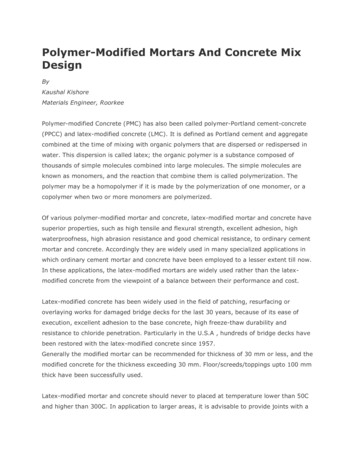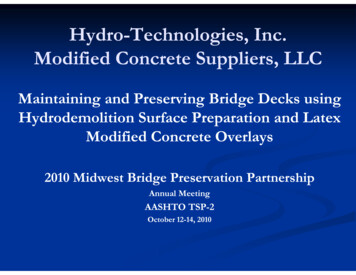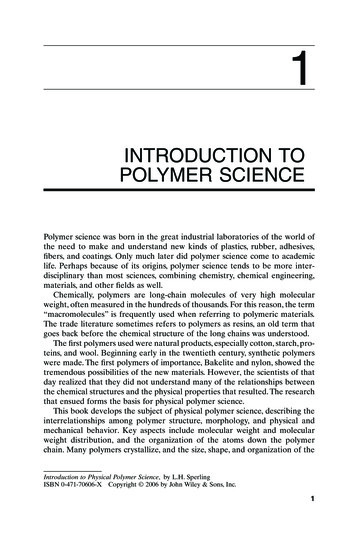
Transcription
Polymer-Modified Mortars And Concrete MixDesignByKaushal KishoreMaterials Engineer, RoorkeePolymer-modified Concrete (PMC) has also been called polymer-Portland cement-concrete(PPCC) and latex-modified concrete (LMC). It is defined as Portland cement and aggregatecombined at the time of mixing with organic polymers that are dispersed or redispersed inwater. This dispersion is called latex; the organic polymer is a substance composed ofthousands of simple molecules combined into large molecules. The simple molecules areknown as monomers, and the reaction that combine them is called polymerization. Thepolymer may be a homopolymer if it is made by the polymerization of one monomer, or acopolymer when two or more monomers are polymerized.Of various polymer-modified mortar and concrete, latex-modified mortar and concrete havesuperior properties, such as high tensile and flexural strength, excellent adhesion, highwaterproofness, high abrasion resistance and good chemical resistance, to ordinary cementmortar and concrete. Accordingly they are widely used in many specialized applications inwhich ordinary cement mortar and concrete have been employed to a lesser extent till now.In these applications, the latex-modified mortars are widely used rather than the latexmodified concrete from the viewpoint of a balance between their performance and cost.Latex-modified concrete has been widely used in the field of patching, resurfacing oroverlaying works for damaged bridge decks for the last 30 years, because of its ease ofexecution, excellent adhesion to the base concrete, high freeze-thaw durability andresistance to chloride penetration. Particularly in the U.S.A , hundreds of bridge decks havebeen restored with the latex-modified concrete since 1957.Generally the modified mortar can be recommended for thickness of 30 mm or less, and themodified concrete for the thickness exceeding 30 mm. Floor/screeds/toppings upto 100 mmthick have been successfully used.Latex-modified mortar and concrete should never to placed at temperature lower than 50Cand higher than 300C. In application to larger areas, it is advisable to provide joints with a
width of about 15 mm at intervals of 3 to 4m. Generally polymer latex used as cementmodifiers are not toxic, and are safe materials to handle. Consequently they require notspecial precautions.Materials:The materials used in latex-modified mortars and concrete are the same as those employedin ordinary Portland cement mortar and concrete.Cements:Ordinary Portland cement is widely used for latex-modified mortar and concrete. Accordingto their applications, other Portland cement such as high-early-strength Portland cement,ultra high-early strength Portland cement, sulphate resisting Portland cement, moderateheat Portland cement and white Portland cement, blend cement and super high-earlystrength cement are employed. Air-entraining cement should not be used because of airentrainment due to latex addition.Polymer Latexces:In particular, the commercial latexces widely used in the world are styrene-butadienerubber (SBR). It is estimated that over 9000 bridge decks alone in USA are protected withSBR Latex system, polychloroprene rubber (CR), polyacrylic ester (PAE), Poly (ethylenevinyl accetate) (EVA) and poly (vinylidene chloride-vinyl chloride) (PVDC) copolymers. Mostcommercial polymer latexes for cement modifiers contain proper antifoaming agents, andcan be generally used without addition of the antifoaming agents during mixing.Powdered Emulsions:At present commercially available powdered emulsions are VA/VeoVa, poly vinyl accetatevinyl versatate and EVA, Poly-ethylene-vinl accetate. Generally the powdered emulsions aredry blended with cement and aggregates mixtures, followed by wet mixing with water.During the wet mixing, the powdered emulsions are re-emulsified, if necessary, anantifoaming agent is added to the wet mix. The curing of the modified system is similar tothat of the latex-modified systems.Aggregate:Fine and coarse aggregates such as river sand and gravel, crushed sand and stone, silicasands and artificial lightweight aggregate recommended for ordinary cement mortar andconcrete, are used for latex-modified mortar and concrete. For the purpose of corrosionresistance silica sand and siliceous crushed stones may also be used. The use of aggregateswith excessive water content should be avoided because the required polymer-cement ratiowill not be achieved.
Mix Proportioning:The mix proportions of most latex-modified mortars are in the range of the cement; fineaggregate ratio 1:2 to 1:3 (by weight), the polymer-cement ratio 5 to 20% and thewater-cement ratio of 30 to 60%, depending on their required workability.The mix proportions of most latex-modified concretes can not be easily determined in thesame manner as those of latex-modified mortars, because of many factors are to beconsidered in the mix design. Normally the polymer-cement ratio of the latex-modifiedconcrete ranges from 5 to 15%, and the water-cement ratio from 30 to 50%. A rational mixdesign system for the latex-modified concrete is described below:This mix design is valid for the following conditions:Types of materials used:Types of cementTypes of aggregates::River gravel:OP cement 53 Grade as per I.S : 12269-1987.River sand of Zone II & III as per IS: 383-1970. It shouldnot contain particles coarser than 2.5 mm.5-20 mm and 5-10 mm i.e 20 and 10 mm gradeduncrushed aggregate as per IS: 383-1970.(both the above aggregates saturated and surface dry)Polymer Latexes:commercial polymer latexes, irrespective polymer types(containing antifoamers)Range of proportions in practical use:Unit cement content (C):Polymer-cement ratio (P/C):Water-cement ratio (W/C)SlumpCompressive Strength (fck)Air (by Volume)From 250 to 400 kg/m3 for 20 mm maximumsize of aggregateFrom 0.05 to 0.20 (5 to 20% by wt. of polymerwith respect to cement)From 0.30 to 0.50 (30 to 50% by wt. of waterwith respect to cement)50 mm to 200 mmFrom 200 to 600 kg/cm22% in 20 mm maximum size aggregate3% in 10 mm maximum size aggregateThe procedure for determining the mix proportions of latex-modified concrete is carried outaccording to the following steps:Step 1 : The required workability of fresh latex-modified concrete and the performance ofhardened latex-modified concrete are determined corresponding to its field applications.
Step 2: The polymer-cement ratio (P/C) to give the required properties is determined on thebasis of the information shown in catalogs and technical data by the manufacturers ofpolymer latexes for cement modifiers. Simultaneously the binder-void ratio to satisfy therequired fck and P/C is determined by using an equation for compressive strengthprediction.Step 3: Prediction of compressive strength : (2 days moist 3 days wet and 10 days drycured) – Regardless of polymer type, the compressive strength latex-modified concrete canbe predicted at polymer-cement ratio of 5, 10, 15 and 20% by using binder-void ratio (q) asfollows:Polymer-cement ratio % fck5 657 q – 4010 595 q – 8815 474 q – 6320 423 q – 88Step 4: The water-cement ratio (W/C) and the unit cement content (C) are estimated byintroducing the determined q from table 1 and 2.Step 5 : From cement quantity and W/C estimate the water content per m 3 of concrete for20 mm maximum size of aggregate. For 10 mm maximum size of agagregate 10% water isto be increased.The obtained water be adjusted after the first trial of slump, see Step. 12.Step 6 : Work out the polymer quantity for the mix.Step 7: Adjust the mixing water from the water in polymer.Step 8: From the table 3 and 4 work out the density of latex-modified concrete.Step 9: Work out the total aggregate content of the mixDensity – (Cement Latex Water)Step 10: Work out sand content from table 5.Step 11 : The coarse aggretate total aggregates – sand
Step 12: Adjust the water content after actual slump trials for required workability. With thesame W/C worked out the new cement content and then revised other mix proportions.Example :Calculate the quantity of the different materials required to design a mix for a latexmodified concrete for an anti-corrosive floor.Cement : OPC 53 GradeAggregates: River sand of Zone II, specific gravity 2.65 and graded river gravel 5-20 mmspecific gravity 2.65.Cement modifier: SBR latex, total solids 47.2%, specific gravity of the total solids i.epolymer 1.01Required slump : 100 mmRequired compressive strength (fck) 400 kg/cm2Polymer-cement ratio (P/C): Corrosponding to the required chemical resistance 15% (basedon the chemical resistance data given in the catalog. The latex is SBR.Minimum Cement of the Mix 320 kg/m3Maximum Free W/C ratio 0.45Calculations:Prediction of compressive strength : Substitutingfck 400 kg/cm2 and P/C 15%474 q – 63 400 hence,q (400 63)/474q 0.98Estimation of W/C and cement content from table 1 and 2W/C ratio 43%Cement 330 kg/m3Estimation of water for the mix330 x 0.43 142 kg/m3Estimation of Polymer15/100 x 330 49.5 kg/m3As the specific gravities of the polymer and waer are 1.01 and 1.00 respectively.Slump control factor (49.5/101) (142/1.00) 191 kg/m 3Since the total solids of the SBR latex are 47.2%, the required amount of latex is49.5/0.472 105 kg/m3In which 55 kg is water,Therefore net mixing of water 142 – 55 87 kg/m3
Density from table 4 2335 kg/m3aggregates 2335 – 191 – 330 1814 kg/m3sand from table 5 for trial say 42%sand 1814 x 0.42 762 kg/m3aggregate 1814 – 762 1052 kg/m3Therefore the required quantities of materials per m3 of concrete on the basis of saturatedand surface dry aggregates for the first trial in this example would be as given below:Cement OPC 53 Grade 330 kg/m3SBR Latex 105 kg/m3Water 87 kg/m3River Sand 762 kg/m3River Gravel 1052 kg/m3Density 2336 kg/m3Table. 1Binder-void ratio and W/C ratio with different P/C RatioBinder-void ratio q(by volume)W/C ratio %P/C ratio 351.11.21.330Table. 2 Binder-void ratio and cement concrete with different P/C Ratio
Binder-void ratio ? Unit cement content kg/mP/C ratio %(by 501.053852751.104003151.153601.20400Note: 1. The cement content is for 20 mm maximum size of reiver gravel. For 10 mmmaximum size of river gravel increased the cement content to 15% in each case.
2. Trial mixes should be made to check workability, density and strength, if need be the mixshould be modified as er the required specifications.Table. 3 Estimated wet density of fully compacted latex concrete (kg/m 3),maximum size of aggregate 10 mmSlump control factorl/m3specific gravity of combined aggregates on saturated andsurface dry 2302067213722072277234724020512121219122612331
25020352105217522452315The table is worked out for latex-concrete having cement content of 330 kg/m3. For each 20kg difference in cement content from 330 kg correct the weight per m 3 3 kg in the samedirection.Table. 4 Estimated wet density of fully compacted latex concrete (kg/m3),maximum size of aggregate 20 mmSlump controlfactor l/m3specific gravity of combined aggregates on saturated andsurface dry 22021132183225323232393
23020972167223723072377The table is worked out for latex-concrete having cement content of 330 kg/m3. For each 20kg difference in cement content from 330 kg correct the weight per m 3 3 kg in the samedirection.Table. 5 Proportion of sand (percent) with 10 mm and 20 mm maximum size ofaggregate, slump 50 mm – 200 mmZone of sandFree W/C ratio10 mm aggregate20 mm 0.337-4430-350.438-4631-370.540-4733-39IIITable 6 ACI Guidelines for Mix Proportions of SBR-Modified Concrete OvedrlaysUnit cement content, minimum390 kg/m3Unit SBR Latex content, minimum121 kg/m3Unit water content, maximum94 kg/m3Air content, maximum (ASTM C 2311)6.5%Slump range7.5 – 20.5mmOverlay thickness, minimum2.5 cm
Coarse aggregate size, maximumNo.8Fine aggregate- Aggregate ratio55-70 wt %Cement: Fine aggregate : Coarse aggregate (Aggregateassumed saturated, surface dry)1.0 : 2.8 : 1.7 (weight ratio)References:1. BIS : 12269-1987 “Specifications for 53 grade OPC #, Bureau of Indian Standard, NewDelhi.2. BIS : 383-1970, # Specifications for coarse and fine aggregates from Naltural sources forconcrete (second revision), Bureau of Indian Standard, New Delhi.3. OHAMA, Mix Design System for Polymer-modified mortars, proceeding of the secondAustralian Conference on Engineering Materials, Sydney, Australia, 163-172(1981).4. OHMA.T, NISHIMURA, T.MIYAKE, T and KAN.S. Proposed Mix proportioning of polymermodified concrete, proceeding of the third International Congress on polymer in concrete(Vol. 1), Koriyama, Japan, 320 (1982).5. ACI Committee 546-State-of-the art Report on polymer modified concrete.6. ACI Committee 548-Standard Specification for Latex modified concrete (LMC) overlays.7. KISHORE KAUSHAL, “Concrete Mix Design for Road Bridges “Indian Higheays, Vol. 19,No. 11, November, 1991, pp 31-37.We at engineeringcivil.com are thankful to Sir Kaushal Kishore for submitting this researchpaper and helping all civil engineers understand Polymer-Modified Mortars And Concrete MixDesign.Source: ortars-andconcrete-mix-design.html
In these applications, the latex-modified mortars are widely used rather than the latex-modified concrete from the viewpoint of a balance between their performance and cost. Latex-modified concrete has been widely used in the field of patching, resurfacing or overlaying works for damaged bridge decks for the last 30 years, because of its ease of










